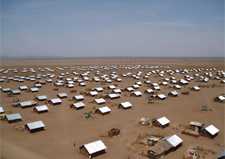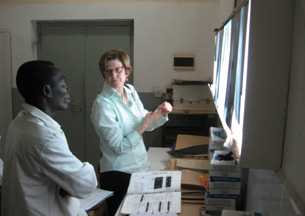Immigrant, Refugee, and Migrant Health Branch
Annual Estimate of People Entering the U.S.
Refugees: ~60,000
Immigrants: ~500,000
Non-immigrants: ~39 million*
Short-term transit: ~35 million
Others: ~4 million
*Non-immigrants include students, temporary workers and trainees, and fiancé(e)s of U.S. citizens.
Each year, close to 60,000 refugees and 500,000 immigrants come to the United States from around the world. Standards of care, access to health care and treatment, and exposure to infectious diseases differ around the world. The U.S. Centers for Disease Control and Prevention’s (CDC) Division of Global Migration and Quarantine (DGMQ) works to keep infectious diseases and other diseases of public health significance from coming into and spreading in the United States. To accomplish this goal, the Immigrant, Refugee, and Migrant Health (IRMH) Branch focuses on promoting and improving the health of immigrants, U.S. bound refugees, and migrants through domestic and overseas programs.
Core Activities
IRMH Branch works with immigrant, refugee, and migrant groups to improve their health by:
- providing guidelines for disease screening and treatment in the United States and overseas,
- tracking and reporting disease in these populations,
- responding to disease outbreaks in the United States and overseas,
- advising U.S. partners on health care for U.S. bound refugee groups, and
- educating and communicating with immigrant and refugee groups and partners.

Kakuma refugee camp in Kenya. Image courtesy of Terry Comans.
Program Areas
IRMH Branch has three teams and five regional field programs that work domestically and overseas to prevent the introduction of infectious disease and promote the health of immigrants and refugees.
Epidemiology Team
The Epidemiology Team works overseas and in the United States to monitor the incidence and prevalence of infectious diseases affecting immigrant, refugee, and migrant populations. The Epidemiology Team:
- develops and maintains infectious disease surveillance systems for immigrant, refugee, and migrant populations coming to the United States,
- conducts disease surveillance and outbreak investigations,
- provides leadership and technical assistance in responding to outbreaks,
- disseminates health information on migrants and refugees for follow-up care to state and local public health partners through the Electronic Disease Notification system, and
- oversees the Migrant Serum Bank, a collection of anonymous immigrant and refugee blood specimens from which samples can be requested for research.

MAP Team member, Captain Mary Naughton, reviews chest x-rays with a panel physician in Ghana.
Medical Assessment and Policy Team
IRMH Branch has the delegated regulatory authority to oversee the quality of overseas medical exams required of immigrants and refugees coming to the United States. To meet this responsibility, the Medical Assessment and Policy (MAP) Team monitors the quality of the medical exams by:
- implementing policies and regulations for the medical exams required for U.S. immigration,
- developing technical instructions for immigrant medical exams,
- conducting onsite visits to examine panel physician facilities and practices, and to evaluate and approve tuberculosis laboratories and radiology facilities,
- training physicians who conduct medical exams overseas, and
- taking steps to reduce fraudulent activities which may be associated with immigrant medical exams.
Domestic Program
Once refugees and immigrants have entered the United States, the Domestic Program:
- provides guidelines to state and local partners on the care of refugee populations,
- works closely with state refugee health coordinators and local partners to monitor the health of refugee populations,
- ensures U.S. bound refugees and immigrants have continuity of care from their overseas exam to domestic follow-up,
- conducts refugee surveillance activities,
- works with partners from the international adoption community to ensure that U.S.–bound adoptees are properly screened and treated for infectious disease, and
- develops health education strategies and products to help state and local partners communicate important health information.
Regional Field Programs
IRMH Branch operates five regional field programs across the world. The largest of these programs are based in Africa (Kenya), Asia (Thailand), and on the U.S.–Mexico Border. The field programs:
- conduct surveillance activities in refugee camps, urban refugee settings, and along the U.S.–Mexico border,
- respond to disease outbreaks in refugee and border settings,
- strengthen international partnerships, and
- conduct local outreach and health education activities.
- Page last reviewed: December 23, 2016
- Page last updated: December 23, 2016
- Content source:


 ShareCompartir
ShareCompartir